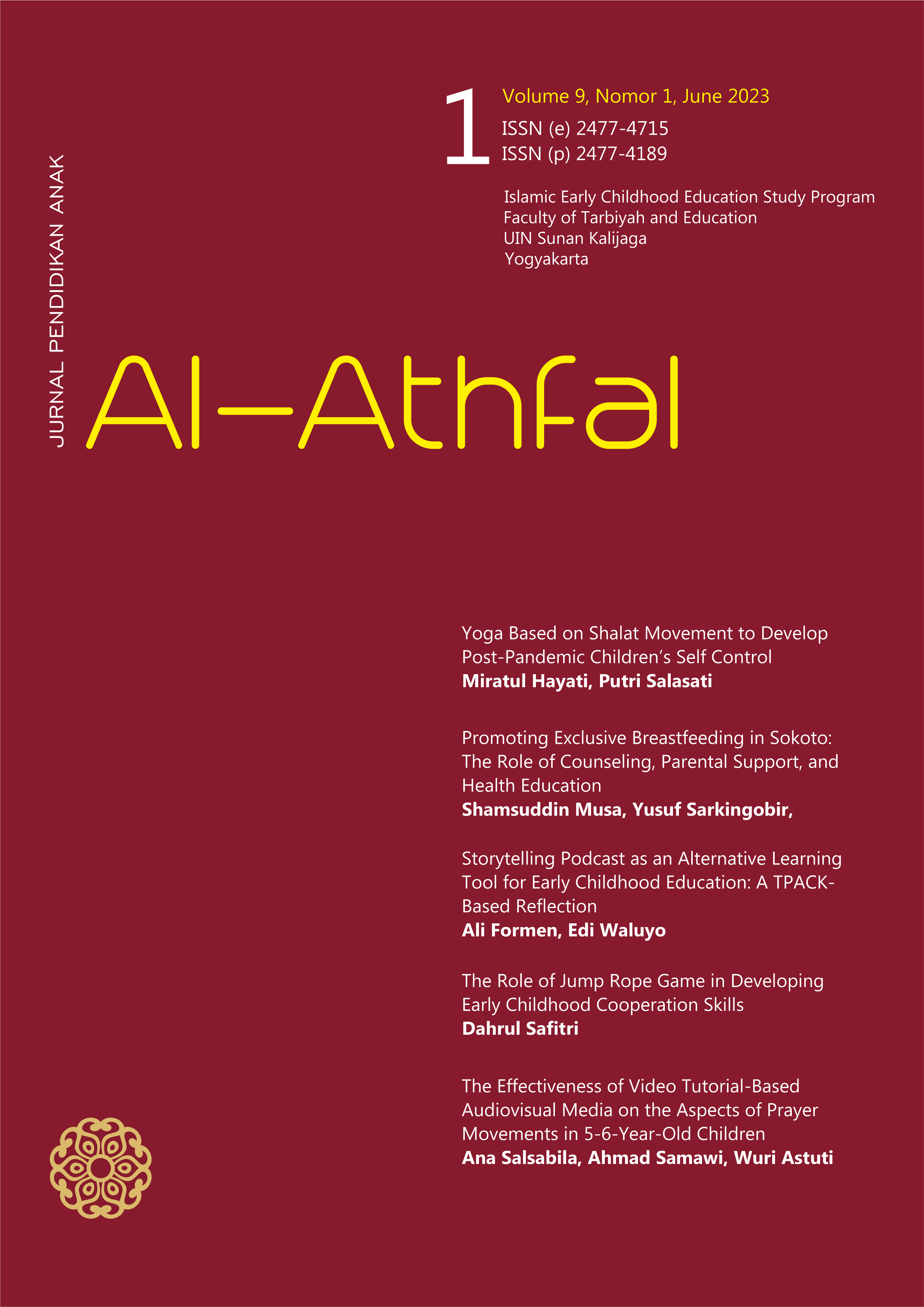293
Views
276
PDF Downloads
 Open Access
Open Access
The Role of Jump Rope Game in Developing Early Childhood Cooperation Skills
Main Article Content
Abstract
Purpose – The proliferation of modern games has gradually eroded the existence of traditional games rich in essential cooperation values for children from an early age. This research aims to analyze the traditional jump rope game as a means to develop early childhood cooperation skills, amidst the prevalence of modern games that emphasize individualism.
Design/methods/approach – This research employs a qualitative approach through a case study. Data collection involves observation, interviews, and documentation. The data analysis technique used follows Miles and Huberman's concept, including data reduction, data presentation, and conclusion drawing. The research informants consist of five parents of children aged 5-6 years, with three boys and two girls as research subjects. Data validity is ensured through source triangulation.
Findings – The jump rope game, commonly known as "lompat karet" due to the use of rubber as the rope in Dukuh Sewelut, demonstrates various positive attributes related to early childhood cooperation skills and positive effects on children's cooperative abilities.
Research implications/limitations – This research has limitations, and its results are not intended to provide general conclusions. However, it is expected that this research can be used to understand similar phenomena.
Practical implications – The findings of this research are expected to enhance our understanding of the importance of traditional jump rope games in building and nurturing early childhood cooperation skills.
Originality/value – Future research will delve into traditional games that can enhance self-regulation skills in children and explore the deeper negative impacts of traditional games.
Paper type Case study
Keywords:
Downloads
Article Details
How to Cite
Copyright

This work is licensed under a Creative Commons Attribution-NonCommercial 4.0 International License.
Authors who publish with this journal agree to the following terms:
- Authors retain copyright and grant the journal the right of first publication with the work simultaneously licensed under a Creative Commons Attribution License that allows others to share the work with an acknowledgment of the work's authorship and initial publication in this journal.
- Authors can enter into separate, additional contractual arrangements for the non-exclusive distribution of the journal's published version of the work (e.g., post it to an institutional repository or publish it in a book), with an acknowledgment of its initial publication in this journal.
- Authors are permitted and encouraged to post their work online (e.g., in institutional repositories or on their website) before and during the submission process. It can lead to productive exchanges and earlier and greater citation of published work.
References
Agustini, F. (2020). Integration of Character Values through Traditional Games “Tarik Tambang” in Science Learning. Jurnal Ilmiah Sekolah Dasar, 4(2), 114–120. https://doi.org/10.23887/jisd.v4i2.24513
Andayani, S. (2021). Bermain Sebagai Sarana Pengembangan Kreativitas Anak Usia Dini. Jendela Olahraga, 2(2), 35-39. https://doi.org/10.26877/jo.v2i2.1700
Anggita, G. M., Mukarromah, S. B., & Ali, M. A. (2018). Eksistensi Permainan Tradisional Sebagai Warisan Budaya Bangsa. JOSSAE (Journal of Sport Science and Education), 3(2), 55–59. https://doi.org/10.26740/jossae.v3n2.p55-59
Barnett, L. A. (1990). Developmental Benefits of Play for Children. Journal of Leisure Research, 22(2), 138-153. https://doi.org/10.1080/00222216.1990.11969821
Hapudin, M. S. (2021). Teori Belajar dan Pembelajaran (Menciptakan Pembelajaran yang Kreatif dan Efektif). Kencana.
Hermawan, D., & Kudus, W. A. (2021). Peran Orang Tua Dalam Mencegah Anak Kecanduan Bermain Game Online di Era Digital. Pendidikan Indonesia, 2(2), 778–789. https://doi.org/10.36418/japendi.v2i5.171
Isnaini, N., & Huda, N. (2020). Pengembangan Media Pembelajaran Kosakata Bahasa Arab Berbasis Permainan My Happy Route Pada Siswa Kelas Viii MTSN 10 Sleman. Al Mi’yar: Jurnal Ilmiah Pembelajaran Bahasa Arab Dan Kebahasaaraban, 3(1), 1-14. https://doi.org/10.35931/am.v3i1.156
Maghfiroh, Y. (2020). Peran Permainan Tradisional dalam Membentuk Karakter Anak Usia 4-6 Tahun. 6(1), 1–8.
Mamik. (2015). Metodologi Kualitatif. Zifatama Publisher.
Moleong, L. J. (2013). Metode Penelitian Kualitatif. PT. Remaja Rosdakarya.
Mulyana, Y., & Lengkana, S. A. (2019). Permainan Tradisional. Salam Insan Mulia.
Paremeswara, M. C., & Lestari, T. . (2021). Pengaruh Game Online Terhadap Perkembangan Emosi dan Sosial Anak Sekolah Dasar. Jurnal Pendidikan Tambusai, 5(1), 1473–1481. Retrieved from https://www.jptam.org/index.php/jptam/article/view/1122
Permadi, A., L Nur’aeni, E., & Nur, L. (2021). Pelestarian Permainan Tradisional Melalui Model Pembelajaran SPADE. Pedadidaktika, 8(1), 83-90. https://doi.org/10.17509/pedadidaktika.v8i1.32742
Puspa Ardini, P., & Lestariningrum, A. (2018). Betmain & Permainan Anak Usia Dini (Sebuah Kajian Teori dan Praktik). Adjie Media Nusantara.
Rahayu, E. D., & Firmansyah, G. (2019). Pengembangan Permainan Tradisional Lompat Tali Untuk Meningkatkan Kinestetic Intelegency Pada Anak Usia 11-12 Tahun. Jendela Olahraga, 4(2), 8-12. https://doi.org/10.26877/jo.v4i2.3611
Rahmawati, E. (2010). Bermain Asyik Permainan Tradisional. Multi Kreasi Satudelapan.
Samsu. (2017). Metode Penelitian (Teori dan Aplikasi Penelitian Kualitatif,Kuantitatif,Mixed Methods,Serta Research&Development). Pusaka.
Saputra, & Rudyanto. (2005). Pembelajaran Kooperatif untuk Meningkatkan Keterampilan Anak TK. DepDiknas, Dikti, Direktorat P2TK2PT.
Sasmita, W. (2018). Tradisi Upacara Ritual Siraman Sedudo Sebagai Wujud Pelestarian Nilai-Nilai Sosial. Jurnal Ilmiah Pendidikan Pancasila Dan Kewarganegaraan, 3(2), 207-214. https://doi.org/10.17977/um019v3i2p207-214
Setiani, R. E. (2019). Pemanfaatan Permainan Tradisionaldalam Penanaman Nilai-Nilai Kebangsaan di TK Negeri Pembina 2 Purwokerto. As-Sibyan, 4(1). https://doi.org/10.32678/as-sibyan.v4i1.1963
Simamora, M., & Nugrahanta, G. A. (2021). Permainan Tradisional dan Kontribusinya untuk Karakter Toleransi Anak, 4(3), 635-648. https://doi.org/10.30605/jsgp.4.3.2021.1410
Srinanda, E. (2018). Menanamkan Budi Pekerti Luhur Sesuai dengan Nilai Nilai Pancasila Melalui Permainan Tradisional, 2(4), 455–461. https://doi.org/10.28926/riset_konseptual.v2i4.88
Sugiyono. (2013). Metode Penelitian Kuantitatif Kualitatif dan R&D. Alfabeta.
Suryawan, I. A. J. (2020). Permainan Tradisional Sebagai Media Pelestarian Budaya dan Penanaman Nilai Karakter Bangsa. Genta Hredaya, 2(2), 1–10. https://doi.org/10.55115/gentahredaya.v2i2.432
Syamsurrijal, A. (2020). Bermain Sambil Belajar: Permainan Tradisional Sebagai Media Penanaman Nilai Pendidikan Karakter. Zahra, 1(2), 1-4. https://doi.org/10.37812/zahra.v1i2.116
Vianugrah, M. J. (2020). Kajian Antropolinguistik Nilai-Nilai Karakter Permainan Anak Tradisional dengan Latar Belakang Kultur Jawa. Tesis. Universitas Sanata Dharman.
Widodo, P., & Lumintuarso, R. (2017). Pengembangan Model Permainan Tradisional untuk Membangun Karakter pada Siswa SD Kelas Atas. Keolahragaan, 5(2), 183-193. https://doi.org/10.21831/jk.v5i2.7215
Widyastuti, I., Savitri, M., Prastianing Tyas, A., Nistiana, S., & Zuliyanti. (2020). Optimalisasi Sekolah Permainan Tradisional Sebagai Wahana Pendidikan Karakter. Panjar, 2(2), 42-47. https://doi.org/10.15294/panjar.v2i2.41309





